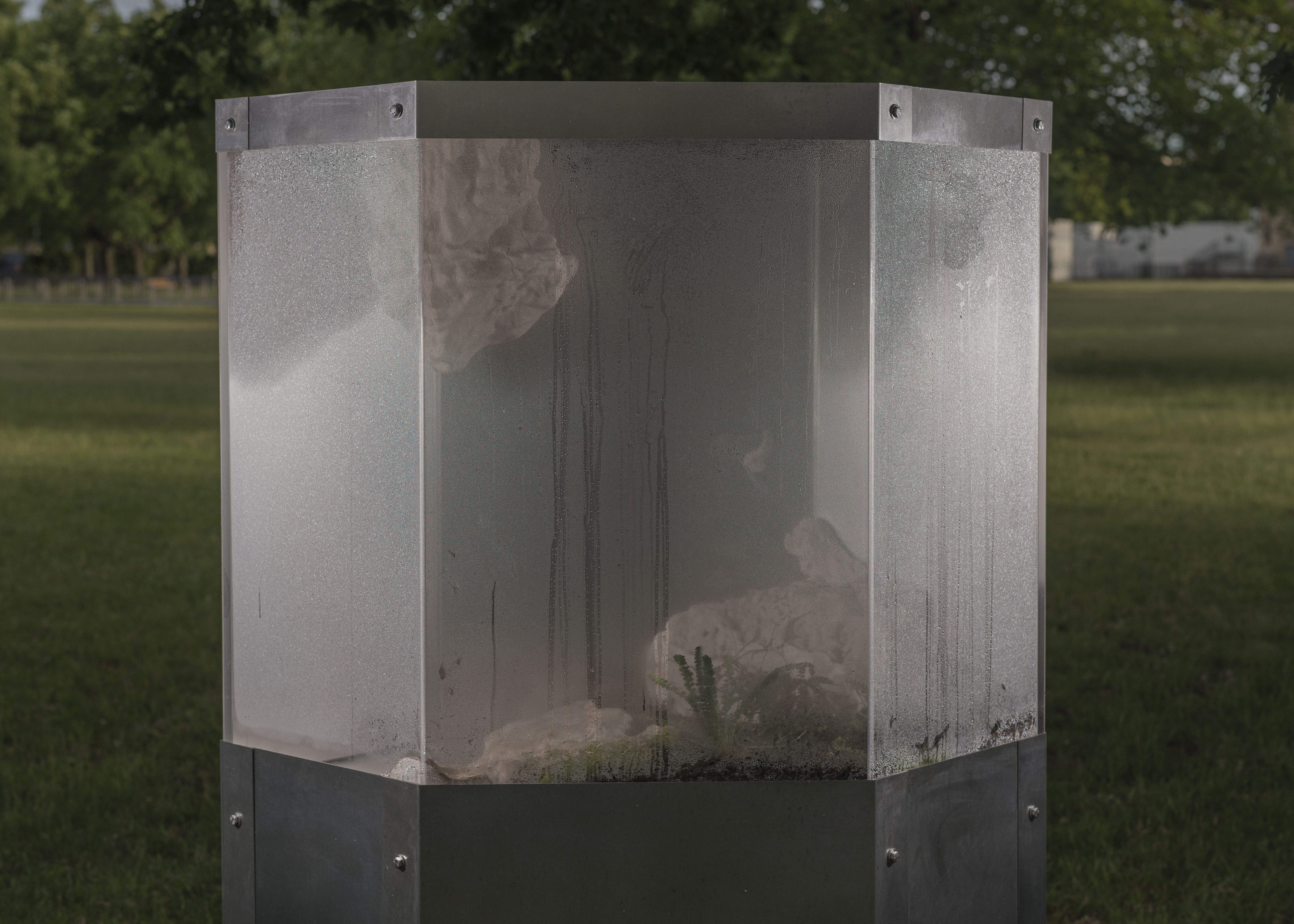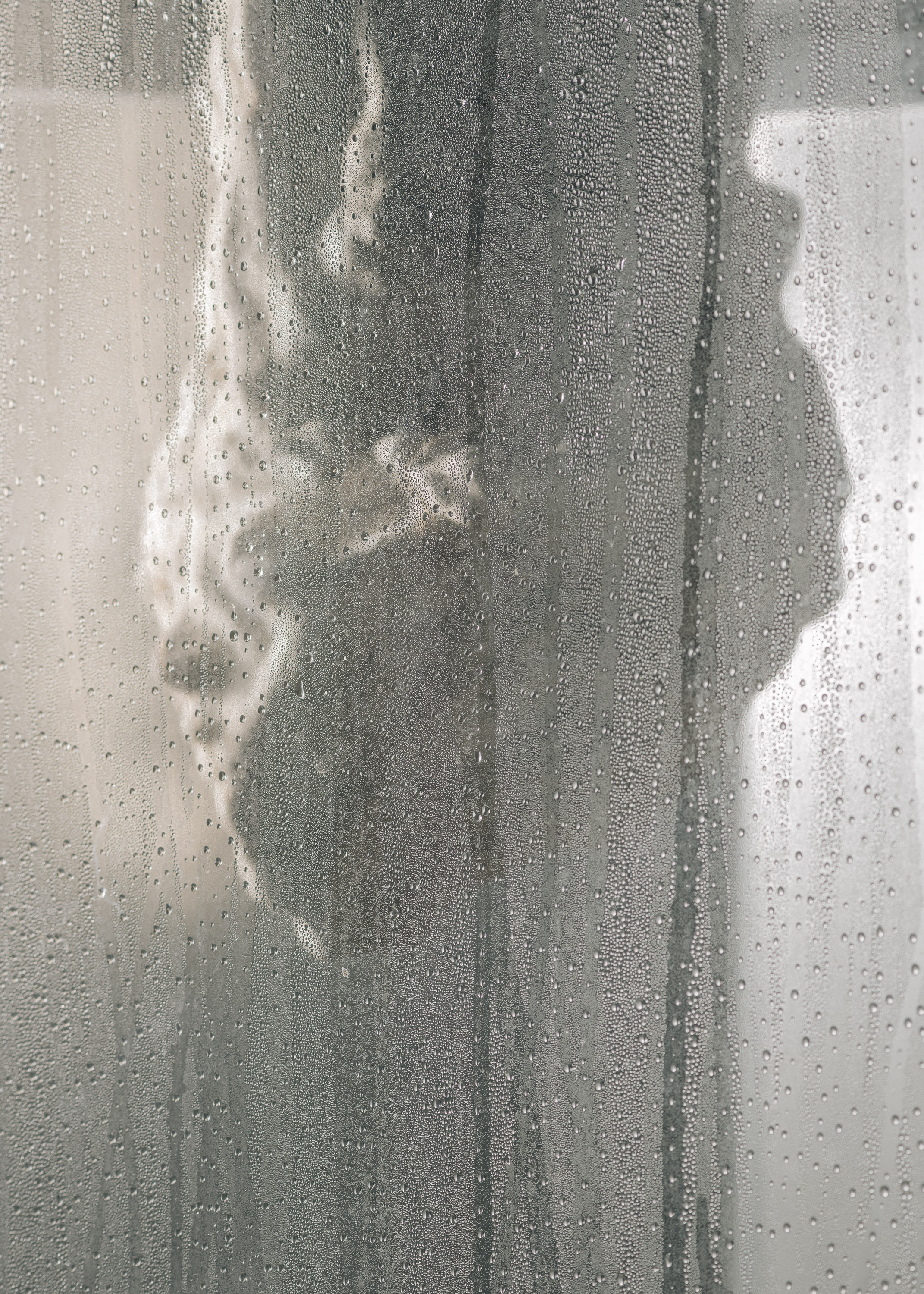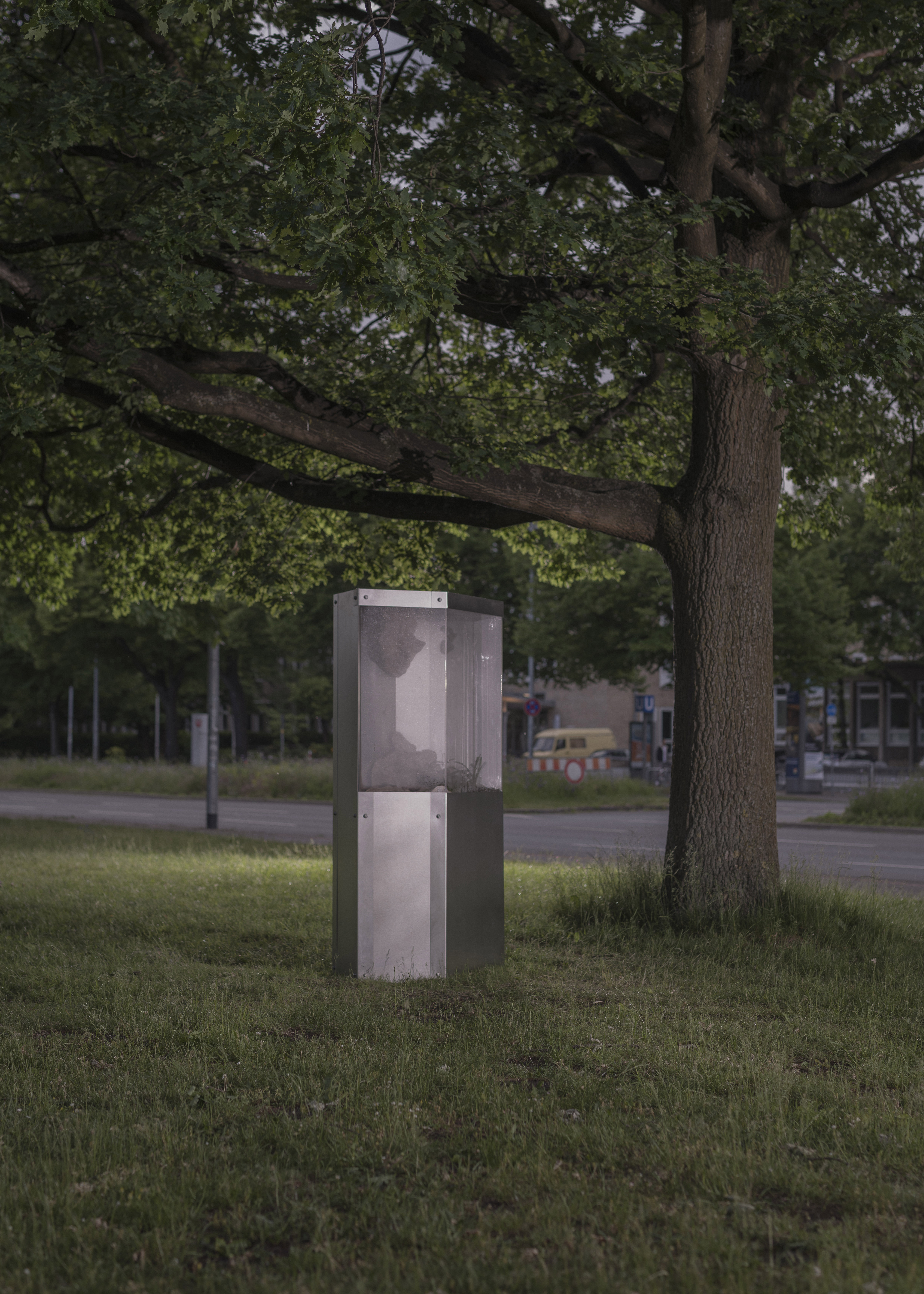MIT LEA SCHÜRMANN
TEXT: FELIX KOBERSTEIN
OFFENE WELTEN / KESTNER GESELLSCHAFT, WATERLOOPLATZ, HANNOVER
FOTOS: VOLKER CRONE
LEA SCHÜRMANN UND CHRISTIAN HOLL HABEN EIN OBJEKT ENTWORFEN, DAS SICH SEINER FORM NACH IN DEN STÄDTISCHEN RAUM EINFÜGT. DASS DIESES OBJEKT ABER KEIN TEIL DER ÜBLICHEN STADTKULISSE IST, SOLLTE SPÄTESTENS KLAR SEIN, NACHDEM SICH HINTER DEM EINGEFASSTEN PLEXIGLASBEHÄLTER DER BLICK AUF EINE HERMETOSPHÄRE AUFGETAN HAT: EIN SICH SELBST DURCH STOFFWECHSELKREISLÄUFE DER DORT BEHEIMATETEN FLORA UND FAUNA REGULIERENDES ÖKOSYSTEM.(...) IM INNEREN DER HERMETOSPHÄRE OFFENBAREN SICH, INMITTEN DES GRÜN, KLEINE UND GRÖSSERE, DEM ANSCHEIN NACH KÜNSTLICH HERGESTELLTE GEGENSTÄNDE. BEI DER HYBRIDEN FORMGEBUNG HABEN SICH DIE KÜNSTLER:INNEN AN NATÜRLICH ENTSTANDENEN TOPOGRAPHISCHEN STRUKTUREN, WIE FELSFORMATIONEN, ABER AUCH AN GESTALTEN LEBENDER ENTITÄTEN ORIENTIERT, DIE UNTEREINANDER FUSIONEN EINGEGANGEN ZU HABEN SCHEINEN. HIERBEI WIRD DER KÜNSTLERISCHE BEZUG AUF DIE AUS DEN NATURWISSENSCHAFTEN STAMMENDE THEORIE DER SYMBIOGENESE DEUTLICH, NACH DER SICH MEHRERE ORGANISMEN ZU EINEM EINZIGEN NEUEN ORGANISMUS ZUSAMMENSCHLIESSEN KÖNNEN. SIE STELLT INSOFERN EINE ERWEITERUNG DER EVOLUTIONSTHEORIE DAR, ALS DASS SOGAR DIE ENTSTEHUNG GÄNZLICH NEUER ARTEN AUF SYMBIOTISCHE BEZIEHUNGEN ZURÜCKGEFÜHRT WIRD. EINES DER BEKANNTESTEN BEISPIELE SIND FLECHTEN - LEBENSGEMEINSCHAFTEN AUS EINEM ODER MEHREREN PILZEN, DIE REGELRECHTE PARTNERSCHAFTEN MIT GRÜNALGEN ODER CYANOBAKTERIEN EINGEHEN.
DIE SKULPTUREN LASSEN SICH IN DIESEM KONTEXT ALS FIKTIONEN MÖGLICHER SYMBIOGENESEN VERSTEHEN. INTERESSANT HIERBEI IST, DASS SICH BEI DEN VERSCHMOLZENEN OBJEKTEN EBENSO AUCH MENSCHLICH ANMUTENDE KÖRPERTEILE ANDEUTEN. DIESE SYMBOLISCHE ABLEHNUNG EINER IMMER NOCH ANERKANNTEN MENSCH-NATUR DICHOTOMIE DARF ALS EIN KLARES BEKENNTNIS GEGEN DEN POSITIVISTISCHEN NARRATIV EINES ANTHROPOZÄNS GELESEN WERDEN, IN DEM DER MENSCH, VON OBEN HERAB, DIE ROLLE DES WELTENRETTERS EINNIMMT. VERSTÄRKT WIRD DIE ANGESTIMMTE ANALOGIE DURCH DIE MATERIALWAHL, DIE BEI
DEN SKULPTUREN AUF EINE OFFENPORIGE UND WASSERDURCHLÄSSIGE ZUSAMMENSETZUNG GEFALLEN IST, SODASS SIE DURCHAUS ALS NÄHRBODEN FÜR DIE IN DER HERMETOSPHÄRE BEHEIMATETEN PFLANZEN UND TIERE DIENEN KÖNNEN - DIE SIMULATION EINER SYMBIOSE AUS KÜNSTLICHEN UND NATÜRLICHEN DINGEN. DIE DIFFUSIONSFÖRDERNDEN EIGENSCHAFTEN DER OBJEKTE HELFEN ZUDEM DABEI DIE LUFTFEUCHTIGKEIT INNERHALB DES PLEXIGLASBEHÄLTERS ZU REGULIEREN.
ÜBER DIE OFFENE WELTEN APP SIND FÜR INTERESSIERTE VON ANDEREN NUTZER*INNEN VERFASSTE PROTOKOLLE ÜBER BEOBACHTUNGEN AN UND MIT DEM OBJEKT, DER HERMETOSPHÄRE IM INNEREN SOWIE DER UMGEBUNG IHRES STANDORTS EINSEHBAR. ZUDEM KÖNNEN WÖCHENTLICH AKTUALISIERTE STATISTIKEN ÜBER TEMPERATUR UND LUFTFEUCHTIGKEIT EINEN EINDRUCK VON DEN LEBENSBEDINGUNGEN IN DER HERMETOSPHÄRE VERMITTELN.
IN DIESEM ZUSAMMENHANG KÖNNEN SENSORISCHE ÜBERWACHUNGSINSTRUMENTE NEU GEDACHT WERDEN UND NICHT NUR ZUR DEMOKRATISIERUNG UND TEILHABE AN DER MACHT ÜBER NATURSCHUTZAUFGABEN DIENEN, SONDERN REGELRECHT ZU EINER NACHBARSCHAFTLICHEN FÜRSORGE ZWISCHEN MENSCH UND NATUR BEITRAGEN. SIE KÖNNEN WERKZEUGE DER INDIVIDUELLEN VERBINDUNG DARSTELLEN, DURCH DIE EIN BEWUSSTSEIN FÜR DIE VERBUNDENHEIT UND ABHÄNGIGKEIT HILFSBEREITSCHAFT HERVORRUFT. DURCH DAS DIGITALE ABTASTEN ENTSTEHEN MENSCH-TIER-SYMBIOSEN, DIE DIE GRENZEN ZWISCHEN KULTUR UND NATUR IMMER WEITER AUFWEICHEN. SO SIND AUCH EINZELNE, SCHEINBAR UNABHÄNGIG LEBENDE KÖRPER KEINE VÖLLIG ABGRENZBAREN PERPETUUM MOBILE, SONDERN SELBST BIOLOGISCHE SYSTEME AUS VIELEN BETEILIGTEN.
DER TITEL DER ARBEIT, TOWER, GEHT IM ÜBRIGEN AUF DIE SCIENCE FICTION ROMAN TRILOGIE SOUTHERN REACH VON DEM US-AMERIKANISCHEN SCHRIFTSTELLER JEFF VANDERMEER ZURÜCK UND STEHT DORT FÜR EINE BESTIMMTE TOPOGRAPHIE, DIE, “WIE EIN UNTERIRDISCHER TURM ANGELEGT”, DAS EPIZENTRUM EINER PARALLELWELT BILDET, IN DER LEBEWESEN VIELSCHICHTIG UND GATTUNGSÜBERGREIFEND SYMBIOTISCHE NETZWERKE BILDEN, WAS ALS EIN HOLISTISCHES KONZEPT DER WELTSICHT VERSTANDEN WERDEN DARF.






MIT LEA SCHÜRMANN
OFFENE WELTEN / KESTNER GESELLSCHAFT, WATERLOOPLATZ, HANNOVER






FOTOS: VOLKER CRONE
TEXT
LEA SCHÜRMANN UND CHRISTIAN HOLL HABEN EIN OBJEKT ENTWORFEN, DAS SICH SEINER FORM NACH IN DEN STÄDTISCHEN RAUM EINFÜGT. DASS DIESES OBJEKT ABER KEIN TEIL DER ÜBLICHEN STADTKULISSE IST, SOLLTE SPÄTESTENS KLAR SEIN, NACHDEM SICH HINTER DEM EINGEFASSTEN PLEXIGLASBEHÄLTER DER BLICK AUF EINE HERMETOSPHÄRE AUFGETAN HAT: EIN SICH SELBST DURCH STOFFWECHSELKREISLÄUFE DER DORT BEHEIMATETEN FLORA UND FAUNA REGULIERENDES ÖKOSYSTEM.(...) IM INNEREN DER HERMETOSPHÄRE OFFENBAREN SICH, INMITTEN DES GRÜN, KLEINE UND GRÖSSERE, DEM ANSCHEIN NACH KÜNSTLICH HERGESTELLTE GEGENSTÄNDE. BEI DER HYBRIDEN FORMGEBUNG HABEN SICH DIE KÜNSTLER:INNEN AN NATÜRLICH ENTSTANDENEN TOPOGRAPHISCHEN STRUKTUREN, WIE FELSFORMATIONEN, ABER AUCH AN GESTALTEN LEBENDER ENTITÄTEN ORIENTIERT, DIE UNTEREINANDER FUSIONEN EINGEGANGEN ZU HABEN SCHEINEN. HIERBEI WIRD DER KÜNSTLERISCHE BEZUG AUF DIE AUS DEN NATURWISSENSCHAFTEN STAMMENDE THEORIE DER SYMBIOGENESE DEUTLICH, NACH DER SICH MEHRERE ORGANISMEN ZU EINEM EINZIGEN NEUEN ORGANISMUS ZUSAMMENSCHLIESSEN KÖNNEN. SIE STELLT INSOFERN EINE ERWEITERUNG DER EVOLUTIONSTHEORIE DAR, ALS DASS SOGAR DIE ENTSTEHUNG GÄNZLICH NEUER ARTEN AUF SYMBIOTISCHE BEZIEHUNGEN ZURÜCKGEFÜHRT WIRD. EINES DER BEKANNTESTEN BEISPIELE SIND FLECHTEN - LEBENSGEMEINSCHAFTEN AUS EINEM ODER MEHREREN PILZEN, DIE REGELRECHTE PARTNERSCHAFTEN MIT GRÜNALGEN ODER CYANOBAKTERIEN EINGEHEN.
DIE SKULPTUREN LASSEN SICH IN DIESEM KONTEXT ALS FIKTIONEN MÖGLICHER SYMBIOGENESEN VERSTEHEN. INTERESSANT HIERBEI IST, DASS SICH BEI DEN VERSCHMOLZENEN OBJEKTEN EBENSO AUCH MENSCHLICH ANMUTENDE KÖRPERTEILE ANDEUTEN. DIESE SYMBOLISCHE ABLEHNUNG EINER IMMER NOCH ANERKANNTEN MENSCH-NATUR DICHOTOMIE DARF ALS EIN KLARES BEKENNTNIS GEGEN DEN POSITIVISTISCHEN NARRATIV EINES ANTHROPOZÄNS GELESEN WERDEN, IN DEM DER MENSCH, VON OBEN HERAB, DIE ROLLE DES WELTENRETTERS EINNIMMT. VERSTÄRKT WIRD DIE ANGESTIMMTE ANALOGIE DURCH DIE MATERIALWAHL, DIE BEI
DEN SKULPTUREN AUF EINE OFFENPORIGE UND WASSERDURCHLÄSSIGE ZUSAMMENSETZUNG GEFALLEN IST, SODASS SIE DURCHAUS ALS NÄHRBODEN FÜR DIE IN DER HERMETOSPHÄRE BEHEIMATETEN PFLANZEN UND TIERE DIENEN KÖNNEN - DIE SIMULATION EINER SYMBIOSE AUS KÜNSTLICHEN UND NATÜRLICHEN DINGEN. DIE DIFFUSIONSFÖRDERNDEN EIGENSCHAFTEN DER OBJEKTE HELFEN ZUDEM DABEI DIE LUFTFEUCHTIGKEIT INNERHALB DES PLEXIGLASBEHÄLTERS ZU REGULIEREN.
ÜBER DIE OFFENE WELTEN APP SIND FÜR INTERESSIERTE VON ANDEREN NUTZER*INNEN VERFASSTE PROTOKOLLE ÜBER BEOBACHTUNGEN AN UND MIT DEM OBJEKT, DER HERMETOSPHÄRE IM INNEREN SOWIE DER UMGEBUNG IHRES STANDORTS EINSEHBAR. ZUDEM KÖNNEN WÖCHENTLICH AKTUALISIERTE STATISTIKEN ÜBER TEMPERATUR UND LUFTFEUCHTIGKEIT EINEN EINDRUCK VON DEN LEBENSBEDINGUNGEN IN DER HERMETOSPHÄRE VERMITTELN.
IN DIESEM ZUSAMMENHANG KÖNNEN SENSORISCHE ÜBERWACHUNGSINSTRUMENTE NEU GEDACHT WERDEN UND NICHT NUR ZUR DEMOKRATISIERUNG UND TEILHABE AN DER MACHT ÜBER NATURSCHUTZAUFGABEN DIENEN, SONDERN REGELRECHT ZU EINER NACHBARSCHAFTLICHEN FÜRSORGE ZWISCHEN MENSCH UND NATUR BEITRAGEN. SIE KÖNNEN WERKZEUGE DER INDIVIDUELLEN VERBINDUNG DARSTELLEN, DURCH DIE EIN BEWUSSTSEIN FÜR DIE VERBUNDENHEIT UND ABHÄNGIGKEIT HILFSBEREITSCHAFT HERVORRUFT. DURCH DAS DIGITALE ABTASTEN ENTSTEHEN MENSCH-TIER-SYMBIOSEN, DIE DIE GRENZEN ZWISCHEN KULTUR UND NATUR IMMER WEITER AUFWEICHEN. SO SIND AUCH EINZELNE, SCHEINBAR UNABHÄNGIG LEBENDE KÖRPER KEINE VÖLLIG ABGRENZBAREN PERPETUUM MOBILE, SONDERN SELBST BIOLOGISCHE SYSTEME AUS VIELEN BETEILIGTEN.
DER TITEL DER ARBEIT, TOWER, GEHT IM ÜBRIGEN AUF DIE SCIENCE FICTION ROMAN TRILOGIE SOUTHERN REACH VON DEM US-AMERIKANISCHEN SCHRIFTSTELLER JEFF VANDERMEER ZURÜCK UND STEHT DORT FÜR EINE BESTIMMTE TOPOGRAPHIE, DIE, “WIE EIN UNTERIRDISCHER TURM ANGELEGT”, DAS EPIZENTRUM EINER PARALLELWELT BILDET, IN DER LEBEWESEN VIELSCHICHTIG UND GATTUNGSÜBERGREIFEND SYMBIOTISCHE NETZWERKE BILDEN, WAS ALS EIN HOLISTISCHES KONZEPT DER WELTSICHT VERSTANDEN WERDEN DARF.
TEXT: FELIX KOBERSTEIN
<